Like many people, I used to get these awful headaches and had no idea why. I’d chug some water, pop an ibuilen, and hope for the best. But here’s what I wish someone had told me: 75% of adults in the United States suffer from dehydration according to Next Level Urgent Care, and those headaches aren’t just about needing more water.
After dealing with them for years, I started paying attention to patterns and doing some research. What I discovered completely changed how I think about hydration. We’re not just dealing with being thirsty – there’s some pretty wild stuff happening in your brain that explains why these headaches hurt so much.
Table of Contents
- What’s Really Happening in Your Head During a Dehydration Headache
- The Hidden Blood Vessel Drama That Creates Your Pain
- Why Your Body’s Internal Systems Start Breaking Down
- Why 6 AM Is Your Most Dangerous Hour for Headaches
- The Genetic Lottery That Makes Some People Headache Magnets
- Modern Life Is Secretly Dehydrating You in Ways You’d Never Expect
- What Actually Works When the Pain Hits
- How to Build a System That Stops Headaches Before They Start
TL;DR
- Dehydration headaches happen because your brain cells literally shrink and become super sensitive to normal stuff
- Your blood vessels recruit backup pathways in your brain, creating entirely new pain routes
- The tiny pumps in your cells that manage minerals start failing, making every pain signal worse
- Morning hours (6-10 AM) are when you’re most vulnerable due to overnight water loss and stress hormones
- Some people are genetically wired to be way more susceptible to these headaches
- Screen time, air conditioning, and coffee create hidden dehydration that your body can’t handle
- Standard “drink more water” advice is often too slow – you need the right kind of fluids at the right temperature
- You can actually predict when headaches are coming 4-6 hours ahead of time
What’s Really Happening in Your Head During a Dehydration Headache
Here’s the thing most people don’t realize: when you get a dehydration headache, it’s not because your blood needs more water. The real drama is happening inside your individual brain cells.
I remember sitting in my cubicle one afternoon, squinting at my computer screen with that familiar tight feeling creeping around my head. Sound familiar? That “ugh, not again” moment when you realize a headache is coming.
What’s actually happening is wild – your brain cells are literally shrinking. When you’re dehydrated, water moves out of your brain cells to keep your blood volume stable. This makes your brain cells physically smaller and way more sensitive to normal stuff that usually wouldn’t bother you.
Your brain cells are basically throwing a tantrum when you’re dehydrated, and unfortunately, you’re the one who has to deal with their drama.
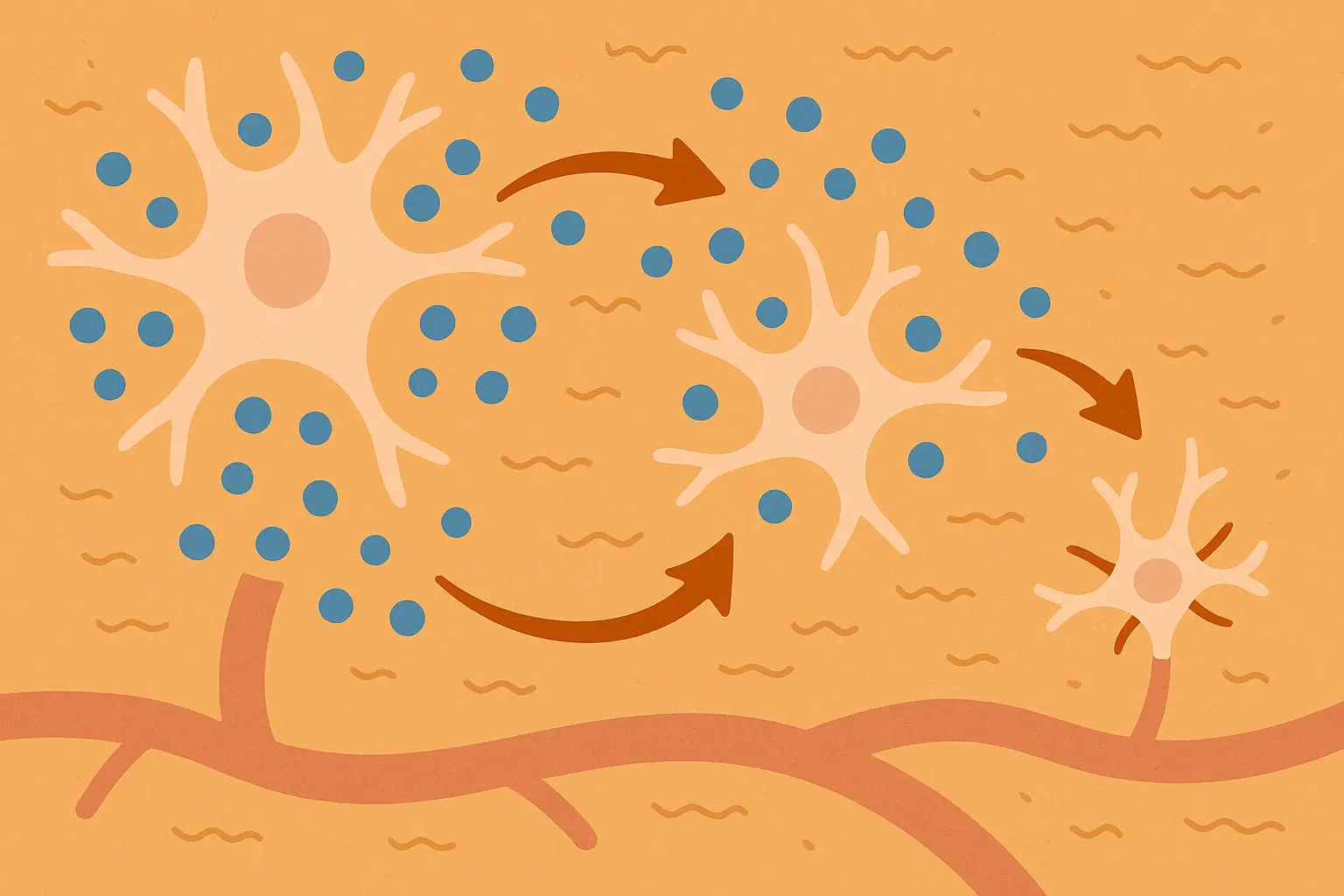
The Star-Shaped Cells That Control Everything
You’ve got these star-shaped cells in your brain called astrocytes that normally keep everything balanced. Think of them as the brain’s maintenance crew. But when dehydration hits, they’re the first ones to freak out.
When these cells can’t do their job properly, they trigger inflammation throughout your brain. This creates the foundation for headache pain before you even feel thirsty.
Ever notice feeling mentally “foggy” before a headache actually starts? That’s your astrocytes struggling. I’ve learned that when simple mental tasks suddenly feel harder – like when reading an email takes way more effort than usual – that’s my early warning system.
Understanding the cellular mechanisms behind brain fog can help you recognize early warning signs of dehydration headache, and implementing targeted strategies to improve mood and brain function through cellular optimization can support your body’s natural hydration balance systems.
“One study found that even short-term fluid restriction (such as 16 hours without water) led to a 0.5 per cent decrease in brain volume” according to News.com.au. So yeah, your brain literally shrinks when you’re dehydrated, pulling away from your skull and irritating all those pain-sensitive areas.
When Your Brain Cells Become Drama Queens
As brain cells lose water, they become unstable and hypersensitive to stuff that would normally be no big deal. It’s like turning up the volume on everything – suddenly normal brain activity starts sending pain signals.
This explains why dehydration headaches feel different from other types. Your brain is literally more sensitive to its own normal functioning. It’s not you being dramatic – your neurons actually are overreacting to everything.
Sarah, a software engineer I know, noticed that her afternoon headaches always started with difficulty concentrating on code reviews. What she figured out was that this mental fog was actually her neurons becoming hypersensitive due to dehydration from her morning coffee routine without enough water. By drinking 16 oz of water immediately when she woke up and setting hourly reminders, she eliminated 90% of her work-day headaches.
What does a dehydration headache feel like? It’s that distinctive all-over pressure that seems to wrap around your entire head – different from the sharp, one-sided pain of migraines or the neck tension you get from stress.
Your Brain’s Backup Blood Vessel System
Here’s where it gets really interesting. During dehydration, your brain doesn’t just randomly mess with blood vessels – it follows predictable patterns by calling in backup vessels that are normally just chilling in the protective layers around your brain.
This creates entirely new pain pathways and explains why dehydration headaches have that “tight band” sensation that’s so different from other headaches.
| Headache Type | Where It Hurts | What It Feels Like | When Dehydration Triggers It |
|---|---|---|---|
| Dehydration | All-over “tight band” | Dull, throbbing | When you’ve lost >2% of your body weight in fluids |
| Tension | Back of head/neck | Steady pressure | Stress plus mild dehydration |
| Migraine | One-sided | Sharp, pulsing | Severe dehydration can trigger these |
| Cluster | Around one eye | Intense, stabbing | Rarely related to dehydration |
How Your Brain Calls in Reinforcements
The blood vessels in the protective layers around your brain (called meningeal vessels) are normally just hanging out doing nothing. But when your brain needs more blood flow to deal with dehydrated cells, it activates these backup vessels.
The problem? These backup vessels happen to be connected to pain-sensing nerves. So when they get recruited, you feel it.
I’ve learned to recognize that “tight band” sensation around my head as an early warning sign. It’s actually your brain recruiting these backup blood vessels before the full headache hits.
The Pressure Game Your Head Plays
When you’re dehydrated, blood pools differently in your head. This creates pressure patterns that specifically mess with branches of the trigeminal nerve – basically the main nerve responsible for head and face pain.
This isn’t random. It follows predictable patterns based on how gravity and blood flow work when you don’t have enough blood volume.
Here’s a simple trick that actually works: elevating your head slightly when you first feel dehydration symptoms can help blood drain better and reduce this pressure buildup. You’re working with your body’s natural patterns instead of against them.
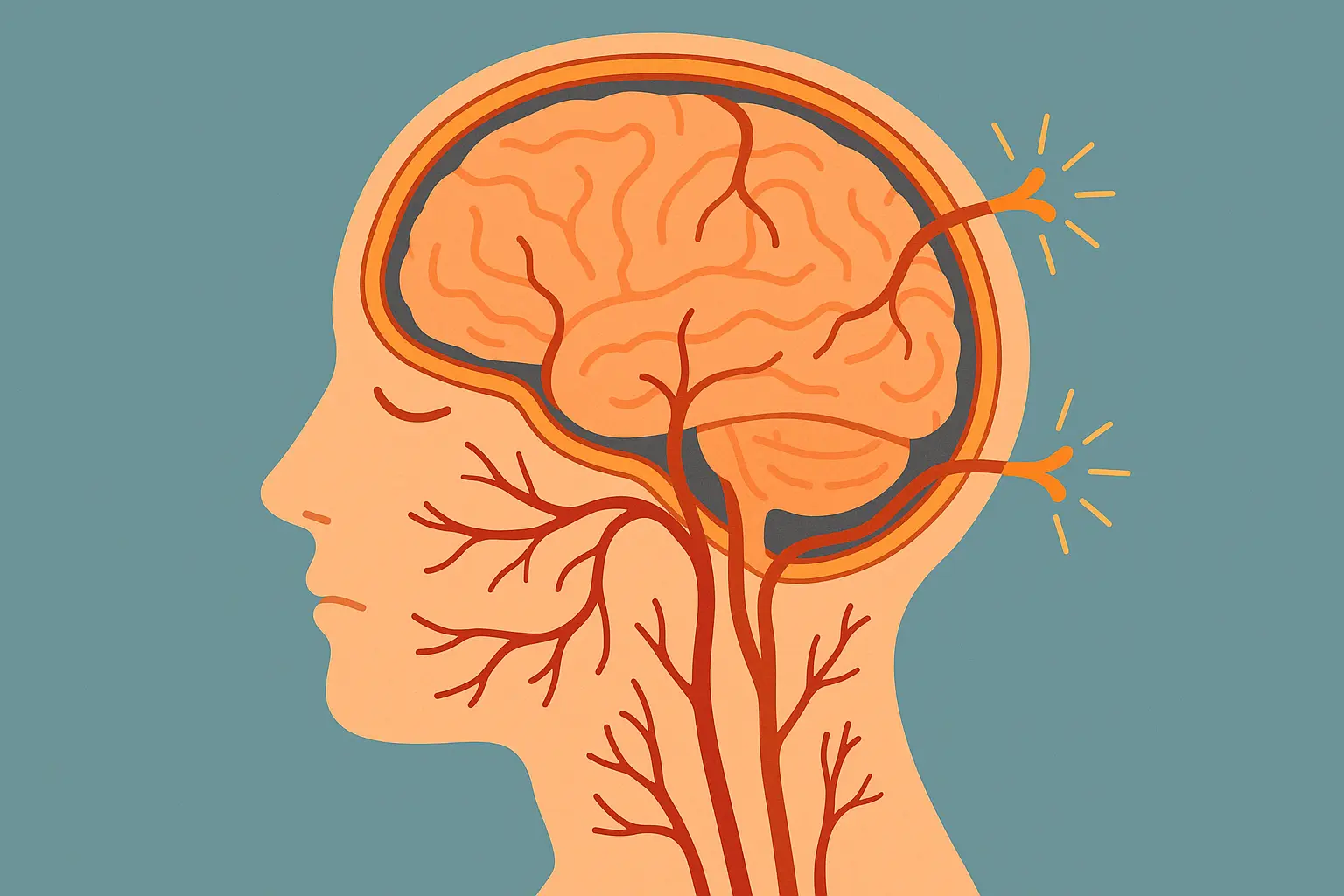
Why Your Body’s Internal Systems Start Breaking Down
Okay, so what does this mean for you? Dehydration creates specific mineral imbalances that directly trigger headache mechanisms. Every cell in your body has these tiny pumps that move sodium, potassium, magnesium, and calcium around. When these pumps start failing, your neurons become hyperexcitable and pain signals get amplified.
Think of it like this: every cell in your brain depends on these microscopic pumps working perfectly. When they start glitching, the problems spread fast through your nervous system.
The Sodium-Potassium Disaster in Every Cell
Every cell in your brain has tiny pumps that constantly move sodium out and potassium in. This keeps your electrical system running properly. When dehydration disrupts these pumps, neurons start firing inappropriately and sending pain signals.
This pump failure is often why dehydration headaches can be so intense and why plain water sometimes doesn’t fix them quickly enough.
I was shocked when I started testing my sweat rate during different activities. Turns out I lose nearly twice as much sodium as the average person during moderate exercise. This explained why I was so prone to afternoon headaches – I was basically running on empty by 2 PM.
The Magnesium Connection Nobody Talks About
Here’s something that blew my mind: even mild dehydration can reveal magnesium deficiency you didn’t know you had. Magnesium is crucial for proper nerve function and blood vessel regulation, but it gets depleted through sweat and stress.
When you’re dehydrated AND magnesium-deficient at the same time, your headache susceptibility goes through the roof.
Understanding how magnesium supplementation works at the cellular level can help you address both the mineral deficiency and hydration aspects of headache prevention more effectively.
Most people are walking around with borderline magnesium deficiency without knowing it. Dehydration just pulls back the curtain on this hidden problem, turning a manageable deficit into a full-blown headache.
Why Your Pain Signals Get Stuck on High Volume
Dehydration makes calcium channels in your pain neurons more likely to open when they shouldn’t. These channels are supposed to open and close in precise patterns, but dehydration makes them hypersensitive.
It’s like someone turned up the volume on your pain system and broke the volume knob.
The good news? Pre-hydrating with drinks that have electrolytes 2-3 hours before you know you’ll be at risk (like long flights or intense workouts) can prevent this from happening in the first place.
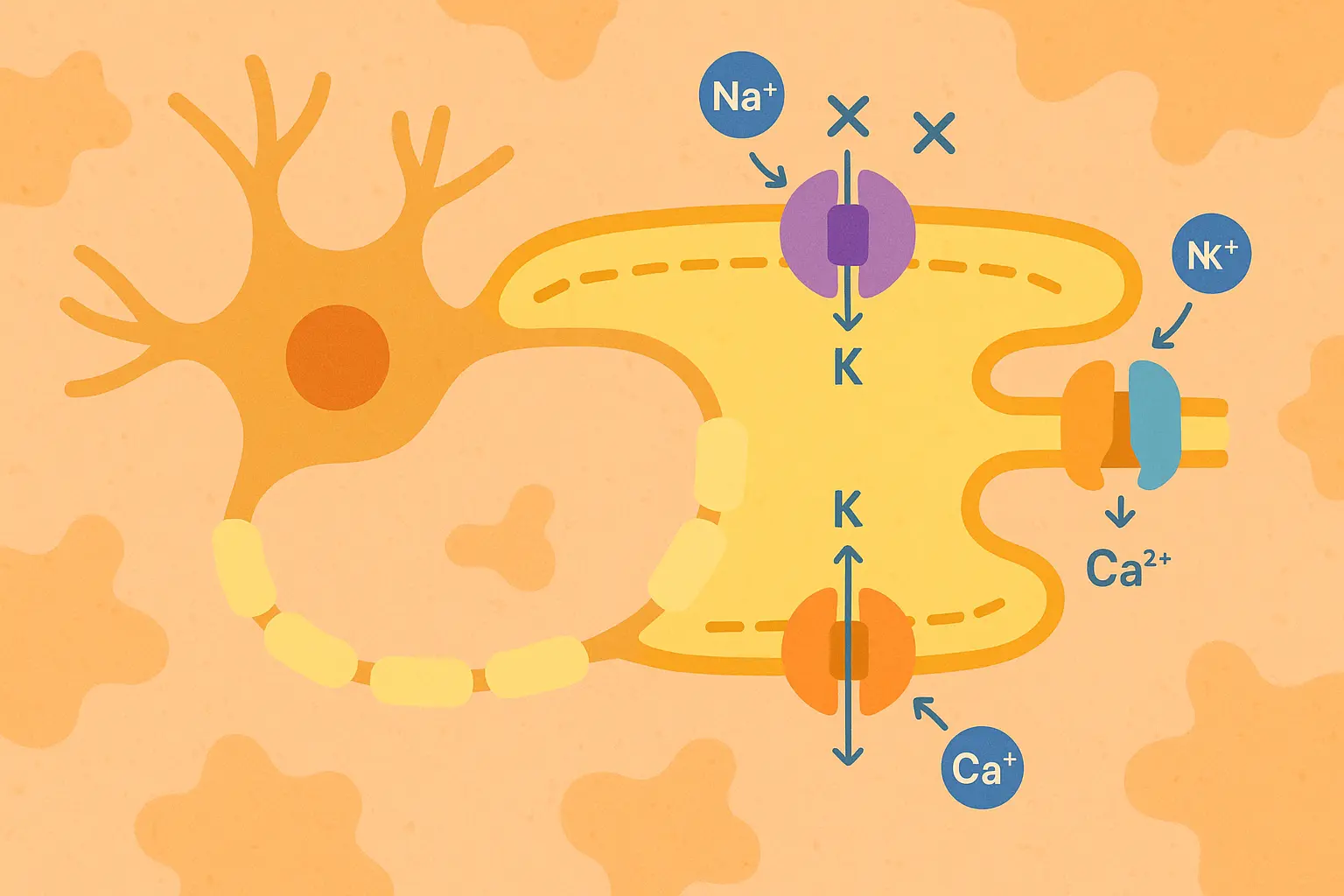
Why 6 AM Is Your Most Dangerous Hour for Headaches
Ever notice how these headaches seem to hit at the worst possible times? There’s actually a reason for that.
Your body’s hydration needs follow precise daily rhythms that most people completely ignore. The morning hours between 6-10 AM are peak danger time because of overnight water loss combined with stress hormones that affect how your body handles fluids.
I started tracking my headache patterns and discovered they clustered around specific times of day. Once I understood why, I could finally get ahead of them instead of constantly playing catch-up.
What does a dehydration headache feel like in the morning? It’s often that dull, pressing sensation that starts behind your eyes and spreads across your forehead, making you feel like your head is in a vise.
The Overnight Water Heist
During sleep, you lose 1-2 pounds of water through breathing and minimal sweating. Most people never account for this predictable morning deficit.
This isn’t about feeling thirsty when you wake up – you’re starting every day already behind on fluids, which primes your brain for headache development.
I started weighing myself immediately when I woke up to track these overnight losses. I was amazed to discover I consistently lose 1.5-2 pounds every night. That’s a significant fluid deficit that explained why I used to get headaches during my morning commute.
Optimizing your sleep hygiene protocols can help minimize overnight fluid losses and reduce morning dehydration headache risk through better temperature regulation and breathing patterns during sleep.
“Staying hydrated is a quick and easy way to manage your stress levels. In a study published this week, researchers at Liverpool John Moores University (LJMU) found that people who do not drink enough water on a daily basis had higher levels of the stress hormone cortisol” according to The Telegraph. This connection between hydration and stress hormones explains why morning dehydration can trigger both headaches and anxiety.
How Morning Stress Hormones Make Everything Worse
Your natural morning cortisol surge affects how your kidneys handle salt and water. When you’re starting the day already dehydrated, this hormonal shift can push you over the headache threshold before you’ve even had breakfast.
My solution: 16-20 oz of water within 30 minutes of waking helps counteract both the overnight losses and the cortisol-induced changes. Adding a pinch of sea salt is especially helpful if you sweat a lot or live somewhere dry.
Mark, a construction foreman, used to get debilitating headaches every morning around 7 AM. After tracking his patterns, he realized he was losing 2.2 pounds overnight and his morning stress hormones were hitting already dehydrated cells. His fix: 20 oz of water with a quarter teaspoon of sea salt immediately upon waking, followed by 8 oz every hour until 10 AM. His morning headaches disappeared within a week.
The Afternoon Perfect Storm (2-4 PM)
The afternoon creates a perfect storm: accumulated fluid losses from morning activities, blood sugar changes from lunch, and that natural energy dip that hits most people.
Small deficits that seemed manageable earlier suddenly add up to significant headache triggers.
| Time of Day | What’s Working Against You | How Likely You Are to Get a Headache | What to Do About It |
|---|---|---|---|
| 6-8 AM | Overnight losses + stress hormone surge | Very High | 16-20 oz water immediately when you wake up |
| 10 AM-12 PM | Morning activities + coffee’s dehydrating effect | Moderate | 8 oz every hour, check your urine color |
| 2-4 PM | All day’s losses + lunch blood sugar crash | High | Drink 12 oz at 1 PM before you need it |
| 6-8 PM | Entire day’s deficit + work stress | Moderate | Electrolyte drink if you’re exercising |
Why Small Problems Become Big Problems
Minor hydration shortfalls from morning activities build up throughout the day. By 2-4 PM, you might be operating at a significant fluid deficit even though you never felt dramatically thirsty.
This gradual buildup is why afternoon dehydration headaches can seem to come out of nowhere.
Setting hydration alarms every 90 minutes from noon to 4 PM has been a game-changer for me. I watch for subtle energy drops that often happen 30-60 minutes before headaches hit.

The Genetic Lottery That Makes Some People Headache Magnets
Here’s something that might make you feel better (or worse, depending): not everyone gets dehydration headaches the same way. Your genes create unique vulnerability patterns that determine how your body processes water, minerals, and pain signals.
Can dehydration cause headaches in everyone? Absolutely, but the threshold and intensity vary wildly based on your genetic blueprint. This explains why your friend can skip water all day without issues while you get a pounding headache after missing just one hydration break.
The Stress Hormone Gene That Changes Everything
Some people have gene variations that make them process stress hormones like dopamine and norepinephrine differently. If you’re a slow processor, you’re more prone to dehydration-triggered headaches when you’re stressed and dehydrated at the same time.
Have you noticed that dehydration headaches hit harder when you’re already stressed? That might be your genes at work.
I’ve found that looking at family history of headaches and their triggers can give you clues about your own genetic setup.
Understanding the importance of genetics in personalized healthcare can help you recognize why your dehydration headache patterns might be different from others and guide more targeted prevention strategies.
Why Some People Are Terrible at Holding Onto Water
Variations in how sensitive you are to antidiuretic hormone (ADH) mean some people need much more precise hydration timing to prevent headaches. If your receptors aren’t very sensitive to ADH, your kidneys don’t get the “hold onto water” message as effectively, making you more prone to rapid dehydration and subsequent headaches.
The Water Channel Efficiency Factor
You have tiny water highways in your cells called aquaporin channels, and they work differently based on genetic factors. Some people have highly efficient channels that allow for rapid rehydration, while others are “slow rehydrators” who need more time and specific strategies to bounce back from dehydration.
Paying attention to whether you’re a “fast” or “slow” rehydrator after exercise can tell you a lot about how your channels work. Slow rehydrators need to be more proactive about prevention rather than relying on quick fixes.
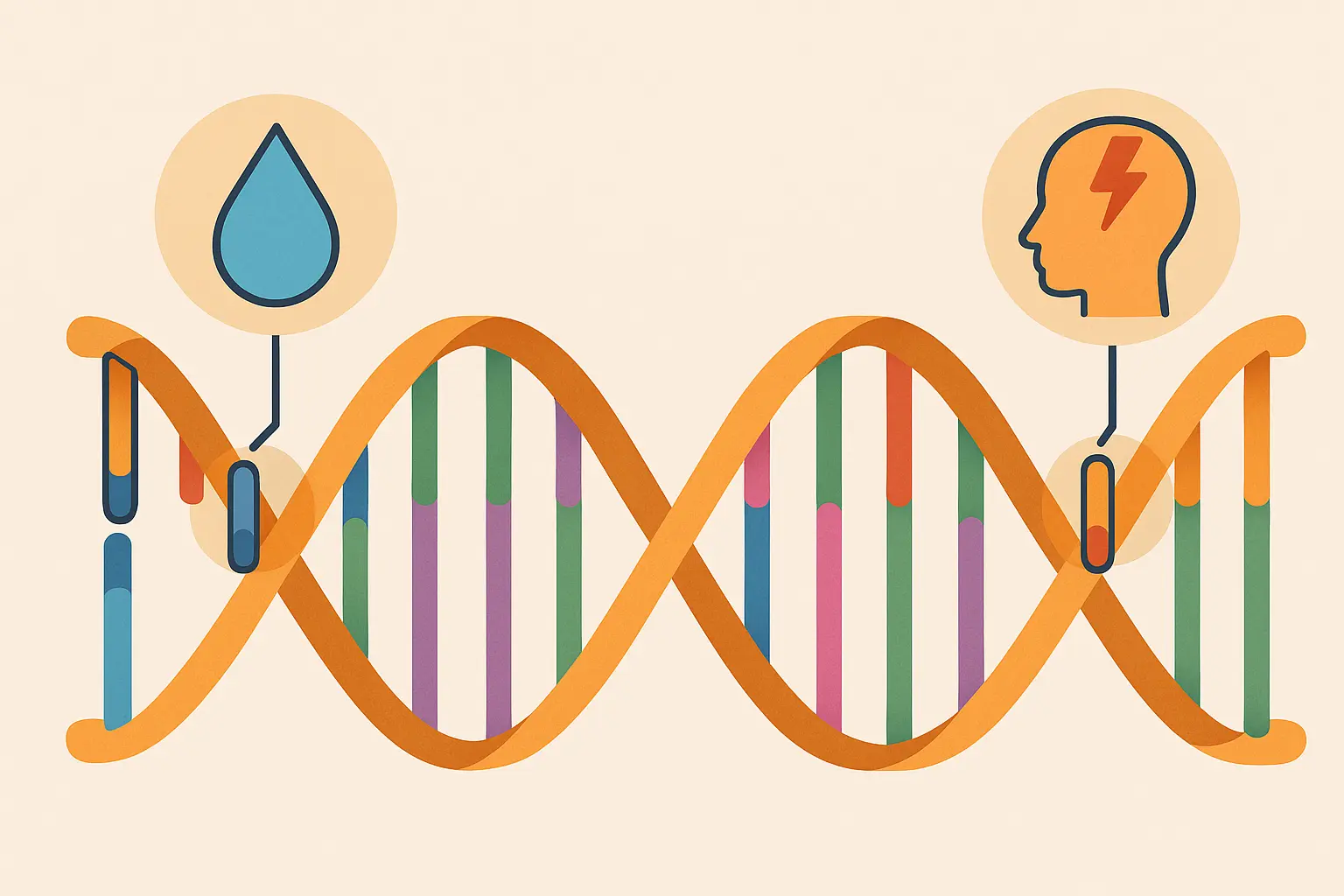
Modern Life Is Secretly Dehydrating You in Ways You’d Never Expect
Look, our ancestors didn’t have to deal with the stuff we do today. Air conditioning, computer screens, and our coffee habits create hidden dehydration that our bodies just haven’t evolved to handle.
Dehydration headaches have become way more common as our environment has become increasingly artificial. We’re dealing with stressors that didn’t exist even 50 years ago.
Your Screen Is Stealing Your Water (Seriously)
This might sound weird, but extended screen use reduces how often you blink and creates eye strain that increases how much fluid your body needs. At the same time, the focused attention required for screen work makes you less aware of dehydration symptoms.
I never connected my afternoon headaches to my screen time until I started using blue light filters and taking regular breaks. The difference was immediate and dramatic.
Air Conditioning Is Messing With Your Natural Instincts
Constant exposure to heated and air-conditioned environments disrupts the natural hydration reflexes that humans developed over thousands of years. Your body loses its ability to accurately gauge fluid needs when temperature and humidity are artificially controlled.
I keep a simple humidity meter on my desk and increase my fluid intake when humidity drops below 40%. It’s a small thing that makes a big difference.
How Coffee Became a Double Agent
Regular caffeine use masks early dehydration symptoms while simultaneously increasing how much fluid you need through its mild diuretic effect. This creates a hidden vulnerability where you don’t realize you’re becoming dehydrated until you’re already past the point where simple rehydration will quickly help.
I cut my coffee consumption in half and was surprised to discover how much more aware I became of my body’s actual hydration needs.
According to the Mayo Clinic, the U.S. National Academies of Sciences, Engineering, and Medicine determined that the average adult male should consume roughly 15.5 cups per day, while the average adult woman should consume 11.5 cups Next Level Urgent Care, yet some studies show the average adult consumes as little as 4 cups of water per day.
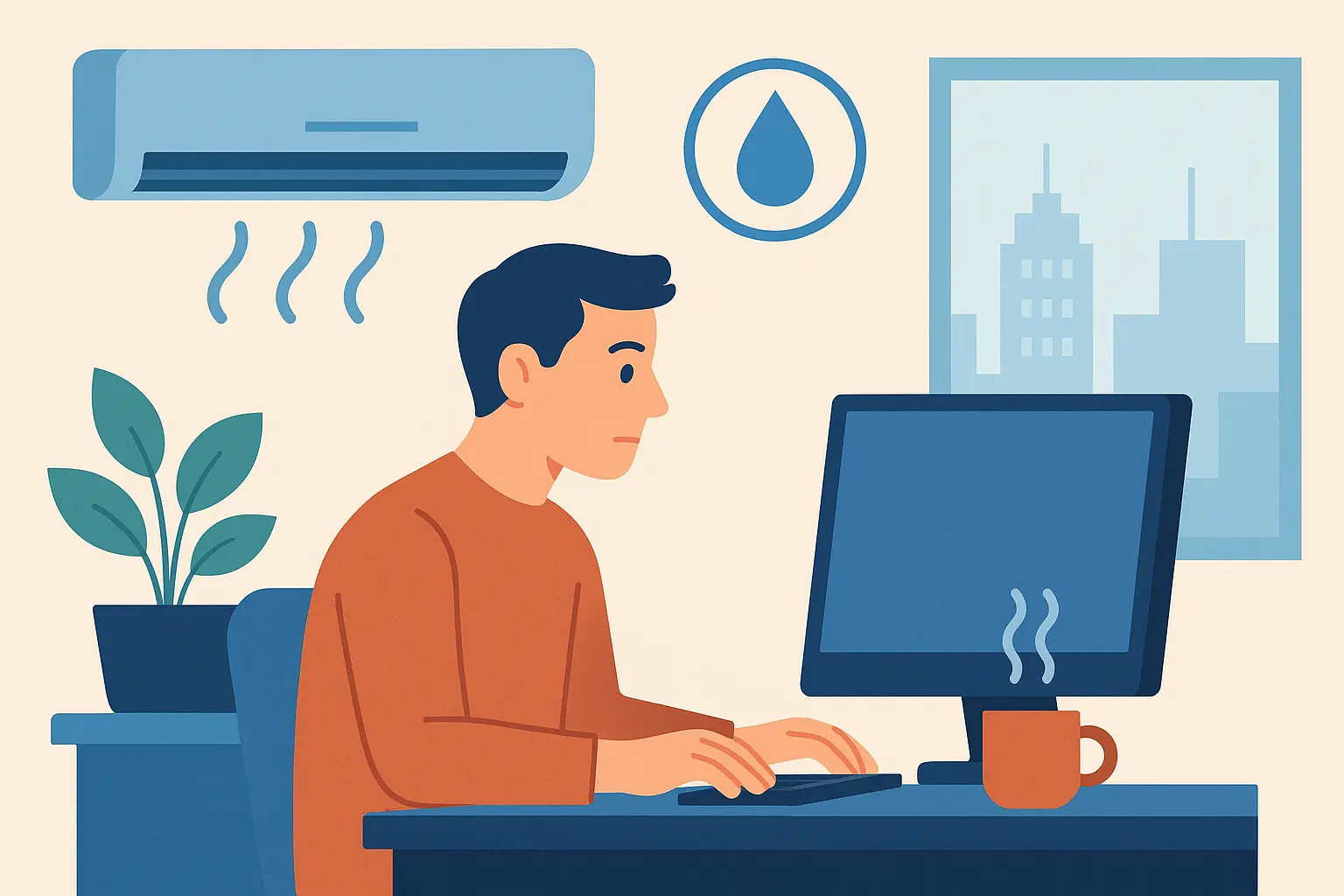
What Actually Works When the Pain Hits
When a dehydration headache strikes, standard “drink more water” advice is often too slow and sometimes makes things worse. You need specific strategies that address what’s actually happening in your cells and blood vessels.
Symptoms of dehydration headache include that characteristic all-over pressure, mental fog, and sensitivity to light or sound. Recognizing these early gives you the best shot at stopping things before they get really bad.
The Science of Getting Fluids Into Your System Fast
Using drinks with specific mineral concentrations that match your blood chemistry allows for faster rehydration without triggering additional problems that can make headaches worse. The concentration of your rehydration drink matters more than most people realize.
When a Headache Hits – What Actually Works:
- Stop all caffeine immediately
- Get somewhere cool and humid if possible
- Drink 8 oz of cool (50-60°F) electrolyte solution
- Prop your head up 15-30 degrees
- Put a cool compress on your forehead
- Follow up with 4 oz every 15 minutes for the next hour
- Check your urine color to see if it’s working
- Get medical help if no improvement in 2 hours
Temperature Matters More Than You Think
Cool (not cold) fluids at 50-60°F get absorbed fastest by your digestive system, while room temperature fluids with electrolytes work best for sustained rehydration. Ice-cold water can actually slow absorption and cause stomach cramping when you’re already dehydrated.
My emergency protocol: 8 oz of slightly cool electrolyte solution immediately, followed by 4 oz every 15 minutes for the next hour. I watch urine color and headache intensity to see how it’s working and avoid large volumes of plain water which can make mineral imbalances worse.
Jennifer, a marathon runner, discovered that her post-race headaches weren’t from exhaustion but from drinking ice-cold water too quickly. She switched to room temperature electrolyte solutions consumed in small, frequent sips and cut her recovery time from 4 hours to 45 minutes.
How to Build a System That Stops Headaches Before They Start
Here’s where it gets really interesting. Using data from wearables and paying attention to environmental factors, you can create a system that predicts dehydration headache risk 4-6 hours in advance.
What does a dehydration headache feel like when you catch it early? Often just a subtle pressure or mild mental fog that most people dismiss. Building awareness of these early signals is crucial.
Your Body’s Early Warning System
This involves combining multiple data streams – heart rate changes, sleep quality, stress levels, and even subtle changes in how well you think – to identify when you’re entering a high-risk state for dehydration headaches. These signals often show up hours before you feel any symptoms.
I track daily weight changes, sleep quality scores from my wearable, and stress levels to create a personal risk assessment each morning. When multiple factors line up unfavorably, I know to be extra careful about hydration.
Daily Headache Risk Check:
- Morning weight loss: _____ lbs (>1.5 lbs = high risk)
- Sleep quality score: _____ /10 (<7 = moderate risk)
- Stress level: _____ /10 (>6 = high risk)
- Weather humidity: _____ % (<40% = moderate risk)
- Planned caffeine intake: _____ cups (>3 = high risk)
- Exercise intensity: _____ /10 (>7 = high risk)
Risk Score: Add 1 point for each risk factor
- 0-1: Low risk – normal hydration routine
- 2-3: Moderate risk – increase intake by 25%
- 4+: High risk – time for prevention mode
Using Your Environment to Stay Ahead
Weather patterns, indoor air quality, travel schedules, and planned activities all affect your fluid needs in predictable ways. Creating hydration schedules based on these factors allows you to stay ahead of dehydration rather than constantly playing catch-up.
Using weather apps to anticipate high fluid-loss days and setting up automated reminders tied to my calendar and activity level has virtually eliminated my surprise headaches. The key is making hydration proactive rather than reactive.
Incorporating strategies to improve deep sleep quality into your prevention system helps optimize overnight recovery and reduces morning dehydration headache vulnerability.
How Enov.one Can Help You Master Your Unique Headache Patterns
The complex relationship between dehydration, how your cells work, and headache mechanisms shows why generic health advice often fails. Enov.one’s comprehensive approach to functional health addresses many underlying factors that make people susceptible to dehydration headaches through personalized assessments that integrate genetic insights, lifestyle factors, and targeted interventions.
Enov.one’s focus on addressing fatigue, brain fog, and mood imbalances through targeted supplementation directly supports the cellular energy systems and brain chemical pathways involved in headache prevention. By optimizing your baseline health through personalized B12, NAD+, and other targeted therapies, you’re building resilience against the cascade of events that turn mild dehydration into debilitating headaches.
Understanding how cellular health optimization works at the molecular level can help you address the root causes of dehydration headache susceptibility rather than just managing symptoms.
The platform’s commitment to ongoing monitoring means your prevention strategy evolves as your body changes, ensuring your approach to hydration and headache prevention remains optimally calibrated to your unique patterns. Ready to stop playing guessing games with your health? Schedule your personalized assessment with Enov.one today and discover what your body actually needs to prevent dehydration headaches before they start.
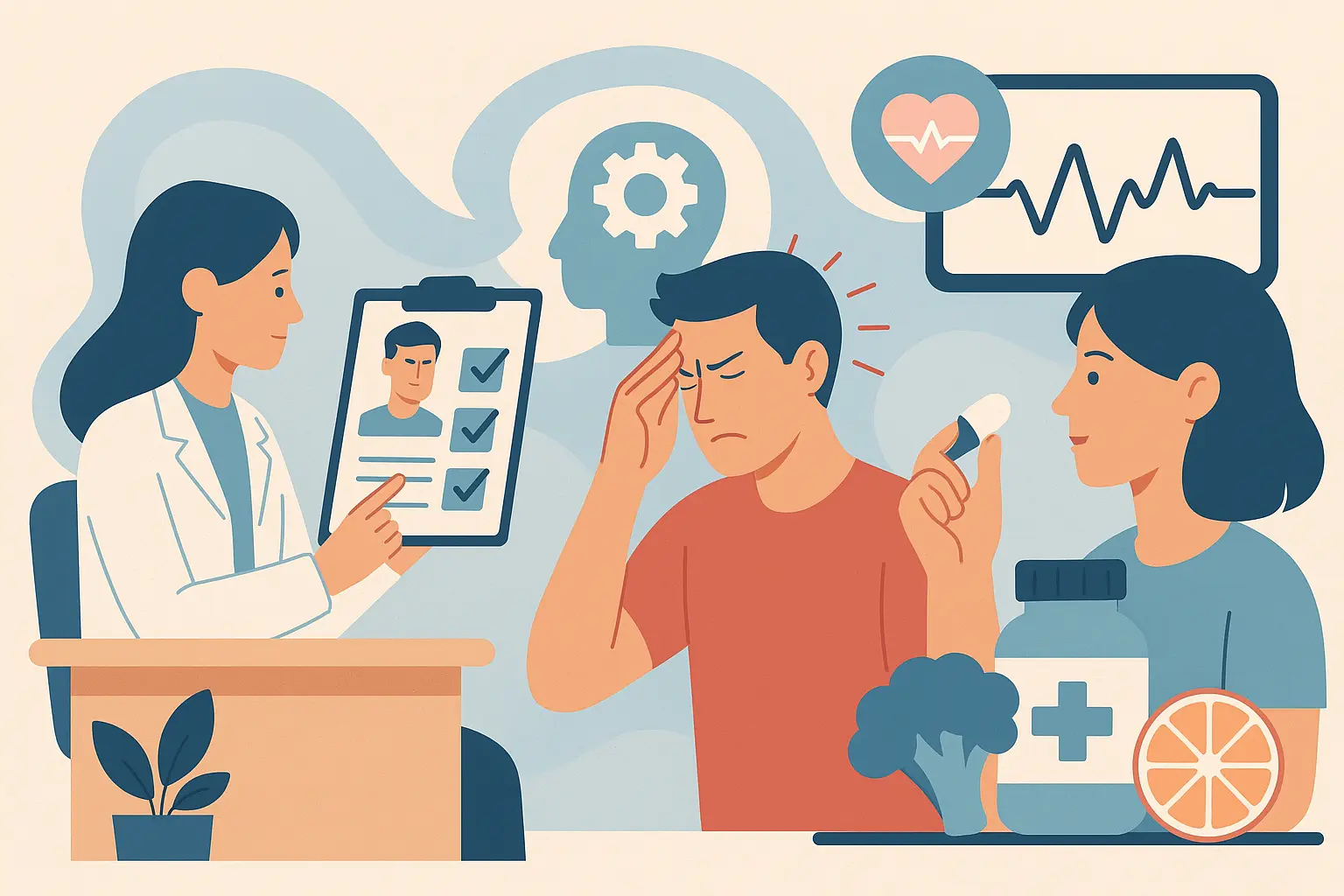
The Bottom Line
Understanding dehydration headaches at this level changes everything about how you approach prevention and treatment. We’re not just dealing with needing more water – we’re supporting complex systems that keep your brain functioning optimally even under stress.
The genetic factors, daily patterns, and modern lifestyle stressors I’ve covered here explain why some people seem immune to dehydration headaches while others get them regularly. More importantly, they give you a roadmap for developing truly personalized prevention strategies that work with your body’s unique patterns rather than against them.
Look, I get it – this might sound like overkill for “just a headache.” But if you’re someone who gets these regularly, you know they’re not “just” anything. Your headache patterns aren’t random, and you don’t have to live with them.
By understanding what’s actually happening with cellular dehydration, blood vessel changes, and mineral disruption, you can build a prevention system that addresses root causes instead of just managing symptoms after they show up.
The relationship between dehydration and headaches becomes manageable once you understand your personal triggers and develop systems that work with your biology instead of fighting against it. You’ve got this.
